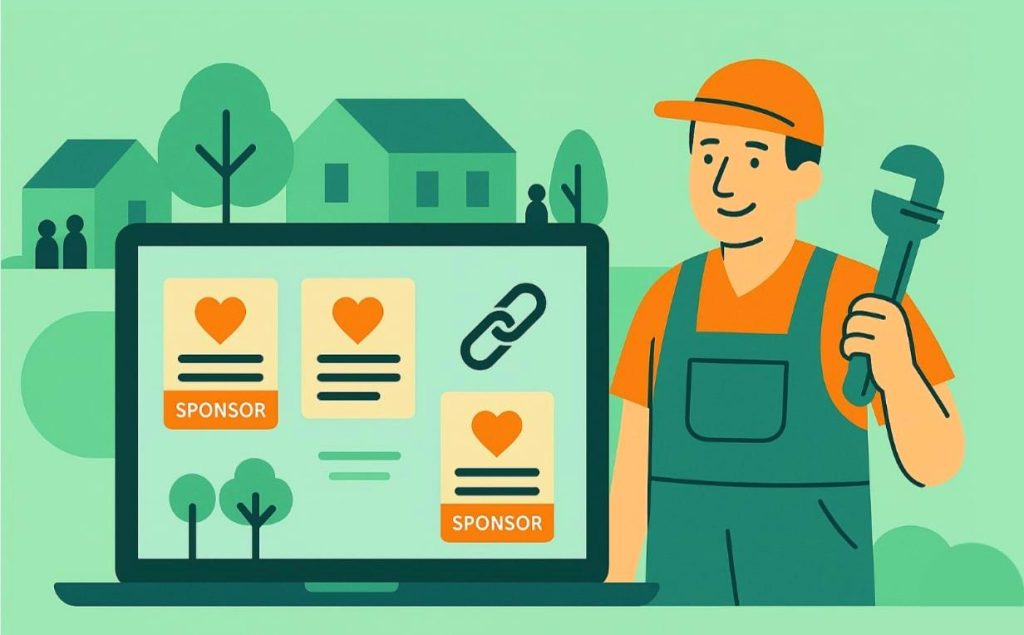
ZipSprout is exploring the idea of “Micro-Sponsorships,” combining our non-profit organization database with microfinance concepts (e.g., Kiva.org and GrameenAmerica.org) to connect sponsors with new or very small non-profits. Micro-Sponsorships could bridge the gap between larger funders and very small, hands-on non-profit organizations. This is the first in a series of ZipSprout blog posts that illustrate our thinking about Micro-Sponsorships, present our research on the viability of Micro-Sponsorships, and track the development of this idea into a core ZipSprout offering.
Based on our analysis, we believe that micro-sponsorships are an effective and under-utilized local opportunity for businesses.
Origins of Micro-Sponsorships
The idea of “Micro-Sponsorships” originated from combining two 21st century ideas in the context of non-profit sponsorships, ZipSprout’s core focus. The first idea is Chris Andersons’s “long tail” – specifically that there is great value in the smaller and more numerous entities hiding behind the few omnipresent brands or blockbusters. In the context of non-profits, ZipSprout is using its organization database to look beyond name-brand national non-profits, such as the American Red Cross, to the thousands of tiny grassroots non-profits operating at a hyperlocal level. This is not to say that the Red Cross should be downplayed – on the contrary the Red Cross is an effective, important organization deserving of support. Rather, the Red Cross plays a specific role as a national organization, and leverages its status to do more good, but it does not focus all its efforts on one neighborhood or one very specific issue, like an organization focused on accumulating supplies for Durham, NC public schools.
There are over 100,000 non-profit organizations and associations with annual budgets of less than $100,000.(1) In other words, there are more than 100,000 organizations with 1 or 0 full-time employees, that do not have the resources for fundraising beyond mere subsistence, that cannot afford to do much more than focus on serving people in need and advocating for positive change. This is the long tail of non-profits.
Additionally, there were almost 65,000 non-profit organizations and associations founded during this decade (2010 – 2020) (1). While some of these are larger organizations, they are all still in a “start-up” phase, establishing themselves and becoming better known in their communities. Many of these organizations also fit into the “long tail” of non-profits.
The second idea underlying “Micro-Sponsorships” is micro-finance, which came to prominence with the success of the Grameen Bank (recipient of the Nobel Peace Prize in 2006), and which has been adopted by numerous start-ups (Kiva.org being a prominent example). More specifically, ZipSprout is looking at a micro-grant model, without repayment of funds (as opposed to micro-loans offered by Kiva.org and the Grameen Bank).
The concept is to provide a small amount of funding – a sponsorship – with no strings attached, beyond sponsorship packages these organizations have already set up. Like other micro-grant programs that assume an individual will use the micro-grant to better their life or fund an idea, ZipSprout assumes that the non-profit is “doing good” and will use the Micro-Sponsorship to continue “doing good.” Cynics may take this as a leap of faith, but the simple existence of these organizations is an indication to ZipSprout that they will make good use of these funds.
Micro-Sponsorships and the ZipSprout Model
At ZipSprout, we facilitate matches between non-profit organizations, associations, and events and companies seeking hyperlocal branding. It’s marketing while doing good! We are deep in the grassroots of the non-profit scene, so we see the local non-profits working tirelessly to serve their communities while hoping that someone will support their work. We also see the corporate side, where companies try to gracefully manage hundreds of requests for donations while balancing their reputations and complementing their brand missions. We hope that Micro-Sponsorships at ZipSprout will solve both problems – getting funding to these small non-profits in a way that aligns with brand missions and target topics/locations.
The Micro-Sponsorship concept may be best illustrated by looking at some of the largest foundations in the U.S. These foundations give out millions of dollars in grants each year, but the smallest grants are in the thousands of dollars range and require applications and reporting by the grantee. Tiny non-profits just don’t have the capacity to go after these grants. Companies face similar issues, with many companies requiring non-profits to apply for a donation and/or relying on word of mouth to decide what non-profits to sponsor. Again, tiny non-profits don’t have the capacity to apply, nor are they able to generate steady word of mouth beyond their Board members.
Minimum grant amount and number of grants under $1,000 are for 2015 as reported by each foundation.
| Foundation(2) | Average Grant Amount | Minimum Grant Amount | Number of Grants Under $1,000 |
| Bill & Melinda Gates Foundation | $724,000 | $500 | 11 |
| Ford Foundation | $320,000 | $10,000 | 0 |
| J. Paul Getty Trust | $40,000 | $1,000 | 0 |
| The Robert Wood Johnson Foundation | $111,000 | $10,000 | 0 |
| W. K. Kellogg Foundation | $221,000 | $2,500 | 0 |
The ZipSprout model connects companies to local non-profits, so Micro-Sponsorships are a simple extension of that model. Rather than identifying specific sponsorship opportunities, we can search our database to identify a slate of non-profits based on geography, topic, age/size of the organization, or a combination – whatever aligns with the company’s mission, goals, and interests. Then, instead of choosing one or two larger sponsorship opportunities, the company can make 10, 15, 20, or more Micro-Sponsorships to those tiny non-profits that wouldn’t expect a big company to find them yet could really use their support.
Micro-Sponsorships – First Glance
As we stated at the beginning, we are exploring how to implement Micro-Sponsorships, and if it even makes sense to do so (spoiler – it does!). At this point, let’s lay out how a Micro-Sponsorship might actually work. If you are interested in being among our initial Micro-Sponsors and helping us make this concept work, please get in touch – hello@zipsprout.com.
A Micro-Sponsorship is a mechanism allowing a company to make one donation split among multiple deserving organizations – instead of one $50,000 donation to one organization, the $50,000 donation is split between 50 to 200 smaller organizations active in one location, focused on a specific issue, or meeting some other criteria in line with the company’s mission, brand, or preference.
The company contacts ZipSprout and, together, the company and ZipSprout develop parameters for the Micro-Sponsorship. These include:
- total amount
- the amount per Micro-Sponsorship
- the criteria that the non-profits should meet – location, issue, size, etc.
ZipSprout then searches its database of organizations and associations and generates a list of potential Micro-Sponsor recipients. At this point the company can review the list and select specific recipients, or ZipSprout can select the recipients based on criteria (e.g., the 10 most relevant organizations) or randomly. The company will determine how involved it wants to be in these decisions, with full confidence that ZipSprout will make choices fairly and direct donations towards deserving organizations.
Once the Micro-Sponsorship recipients have been selected, ZipSprout will make donations to each organization in the name of the sponsoring company. A tenant of the Micro-Sponsorship concept is that these funds have no strings attached beyond marketing benefits the local organizations already provide to sponsors. ZipSprout will work with each organization to make sure that the donation is recognized on the organization’s Web site and/or social media. Otherwise, that’s it! Given the size of these organizations and their important missions, it is safe to assume that the donation goes towards “doing more good,” and the Micro-Sponsorship does not burden the recipient with an application, evaluation, reporting, or restrictions on what the funds can be used for.
(ZipSprout may contact the organization with a voluntary survey to improve the Micro-Sponsorship concept and to gather testimonials.)
Benefits for the Micro-Sponsorship Donor
Micro-Sponsorships multiply returns for a company in terms of social responsibility, community engagement, and brand awareness. For a donation amount similar to a lower or mid-tier sponsorship of a large event or donation to a large non-profit, the company sponsors 5, 10, 15, or more organizations. The company also establishes itself in a targeted way, be it in a specific location or tied to a specific issue or cause. Finally, the company gets extra props in the non-profit community for supporting the little guy or gal and taking a chance on the tiny grassroots non-profits that do great work and get little attention.
ZipSprout will also work with the sponsoring company on tangential branding and marketing, including press releases describing the Micro-Sponsorships, and Web & social media strategy.
Benefits of Micro-Sponsorships for the Organization
An organization receives a small but significant amount of general funds, tied to a well-known company, with no strings attached beyond the organizations’ previously outlined “thank-you” efforts. The amount will not be overwhelming to a small organization, and there will be no pressure to use the funds on a specific activity, issue, or population.
It is hard to overstate how much impact a donation as low as $250 can make for a tiny organization – that $250 could represent the difference between launching an innovative program and leaving it on “the good ideas” shelf to gather dust. The flexibility tied to the Micro-Sponsorship is also important, as it could allow an organization to cover rent or payroll in an emergency, or help in securing a summer intern, or something as mundane (and as vital) as toilet paper. Finally, the organization won’t have to worry about holding 20%-40% of the funds for reporting or evaluation – important parts of the grant process, but also a burden, particularly for small grants and tiny organizations.
Conclusion
All of us at ZipSprout are excited about the concept of Micro-Sponsorships. It fits our mission, serving both client companies and non-profit organizations and associations. But we want to make sure Micro-Sponsorships make sense, and we want to do it right for everyone involved. We will continue to research and develop our Micro-Sponsorships, and report some of our findings, successes, and failures (hopefully there are none) in the ZipSprout blog. We hope you are as excited by Micro-Sponsorships as we are, and nothing spurs innovation like a committed client, so if you’d like to help us by becoming a Micro-Sponsor please reach out – hello@zipsprout.com.
Note: Statistics on the age and income of non-profit organizations are derived from IRS data and will be expanded upon in subsequent blog posts.
Minimum grant amount and number of grants under $1,000 are for 2015 as reported by each foundation; average grant amounts are for 2014 as reported by the foundation or calculated from Foundation Center profiles; foundations selected from the Top 50 Foundations by Assets as compiled by the Foundation Center (www.foundationcenter.org).
Sources:
(1)irs.gov
(2)gatesfoundation.org
fordfoundation.org
getty.edu
rwjf.org
wkkf.org


